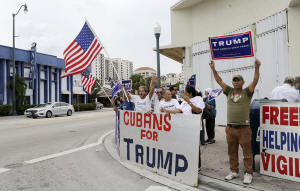Trump's immigration crackdown unnerves Cuban exiles long shielded from
deportation
[May 27, 2025]
By JOSHUA GOODMAN
MIAMI (AP) — Immigration officials said Tomás Hernández worked in
high-level posts for Cuba's foreign intelligence agency for decades
before migrating to the United States to pursue the American dream.
The 71-year-old was detained by federal agents outside his Miami-area
home in March and accused of hiding his ties to Cuba’s Communist Party
when he obtained permanent residency.
Cuban-Americans in South Florida have long clamored for a firmer hand
with Havana and the recent apprehensions of Hernández and several other
former Cuban officials for deportation have been extremely popular among
the politically powerful exile community.
“It's a political gift to Cuban-American hardliners,” said Eduardo
Gamarra, a Latin American expert at Florida International University.
But many Cubans fear they could be next on Trump’s list, he said, and
“some in the community see it as a betrayal.”
Some pleased among Trump fans, others worried
While President Donald Trump's mass deportation pledge has frightened
migrants from many nations, it has come as something of a shock to the
2.4 million Cuban-Americans, who strongly backed the Republican twice
and have long enjoyed a place of privilege in the U.S. immigration
system.
Amid record arrivals of migrants from the Caribbean island, Trump in
March revoked temporary humanitarian parole for about 300,000 Cubans.
Many have been detained ahead of possible deportation.

Among those facing deportation is a pro-Trump Cuban rapper behind a hit
song “Patria y Vida” — “Homeland and Life” — that became the unofficial
anthem of anti-communist protests on the island in 2021 and drew praise
from the likes of then Republican Sen. Marco Rubio, now Secretary of
State. Eliéxer Márquez, who raps under the name El Funky, said he
received notice this month that he had 30 days to leave the U.S.
Thanks to Cold War laws aimed at removing Fidel Castro, Cuban migrants
for many decades enjoyed almost automatic refugee status in the U.S. and
could obtain green cards a year after entry, unlike migrants from
virtually every other country.
Support for Trump among likely Cuban-American voters in Miami was at an
all-time high on the eve of last year’s election, according to a poll by
Florida International University, which has been tracking the
Cuban-American community since 1991. Trump rarely mentions Cubans in his
attacks on migrant targets including Venezuelans and Haitians. That has
given many Cubans hope that they will remain immune to immigration
enforcement actions.
Politics of a crackdown
Democrats, meanwhile, have been trying to turn the immigration crackdown
to their advantage. In April, grassroots groups erected two giant
billboards on Miami highways calling Rubio and Republican Reps. Mario
Díaz-Balart, María Elvira Salazar and Carlos Giménez “traitors” to the
Cuban-American community for failing to protect tens of thousands of
migrants from Trump’s immigration policies.
The arrest of former Cuban state agents is one way to bolster Trump
allies, Gamarra said.
In March, Giménez sent Homeland Security Secretary Kristi Noem a letter
with the names of 108 people he said were former Cuban state agents or
Communist Party officials living unlawfully in the U.S.

“It is imperative that the Department of Homeland Security enforce
existing U.S. laws to identify, deport and repatriate these individuals
who pose a direct threat to our national security, the integrity of our
immigration system and the safety of Cuban exiles and American citizens
alike,” Giménez wrote, adding that the U.S. remains a "beacon of hope
and freedom for those escaping tyranny.”
A mission to topple the government
Giménez's target list was compiled by Luis Dominguez, who left Cuba in
1971 and has made it his mission to topple Cuba's government. In 2009,
when the internet was still a novelty in Cuba, Dominguez said he posed
as a 27-year-old female sports journalist from Colombia to lure Castro’s
son Antonio into an online romance.
[to top of second column]
|

Cuban-Americans chant pro-Trump slogans as they show their support
for Republican presidential candidate Donald Trump in Miami on Oct.
28, 2016. (AP Photo/Alan Diaz, File)

“Some people dream with making money, or with growing old and going
on vacation,” said Dominguez, who lives in Connecticut. “I dream
with seeing my country free.”
With support from the right-wing Foundation for Human Rights in
Cuba, he started combing social media and relying on a well-oiled
network of anti-socialist sources, inside Cuba and outside the
country, to dox officials allegedly behind human rights abuses and
violations of democratic norms. To date, his website, Represores
Cubanos — Cuban Repressors — has identified more than 1,200 such
state agents, some 150 in the United States.
“They're chasing the American dream, but previously they condemned
it while pursuing the Cuban dream,” Dominguez said. "It's the
typical double life of any Communist regime. When they were in power
they criticized anything about the U.S. But now that they're here,
they love it."
Dominguez, 62, said he regularly shares his findings with federal
law enforcement but a spokesman for U.S. Immigration and Customs
Enforcement didn't comment on the agency's relationship with the
activist.
An elite spy department
Enrique Garcia, a former colleague, said he studied with Hernández
in the former Soviet Union in the 1970s. Upon their return,
Hernández was sent to work in the spy agency's elite “North America”
department, said Garcia.
Garcia, who defected to the U.S. in the 1990s and has devoted
himself to helping American spy catchers unmask Cuban agents, said
one-time Cuban agents have infiltrated the current migration wave
while hiding their past and even current loyalties to the Cuban
government.
“You can’t be on both sides at the same time,” he said.
It’s not known when Hernández entered the U.S. and why. U.S.
immigration law generally bars people who’ve belonged to Communist
parties. Anyone caught lying on their green card application can be
deported or prosecuted.

But removing Cubans who are no longer welcome in the U.S. could
prove challenging.
The Trump administration sends a single 60-passenger plane to Cuba
every month as part of its deportation drive, unchanged from the
past year's average, according to Witness at the Border, which
tracks removal flights. At that rate, it would take almost 700 years
to send back the estimated 500,000 Cubans who arrived during the
Biden administration and now lack protected status.
Crackdown on loyal fans
At Versailles Restaurant, the epicenter of Miami's Little Havana,
few among its anti-Communist clientele seemed poised to turn on
Trump, who visited the iconic cafe twice during the recent
presidential campaign. One regular retiree, 83-year-old Rafael
Nieto, even wore a giant Trump 2024 hat and pin.
Most of the aging exiles applauded Trump's migration crackdown
overhaul but there were a few cracks in the GOP armor. As the late
afternoon banter switched between talk of CIA plots to assassinate
Castro and President John F. Kennedy's failure to provide air cover
during the 1961 Bay of Pigs invasion, one retiree stood up and
quietly stepped away from his friends.
“People are trembling,” Tony Freitas, who came to the U.S. from Cuba
in the 1980 Mariel boatlift, said in a hushed voice. “For any little
thing, you could be deported.”
___
AP journalist Gisela Salomon contributed to this report.
All contents © copyright 2025 Associated Press. All rights reserved
 |